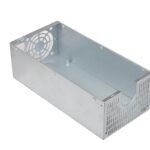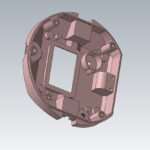Hot and Cold Rolled steels are popular materials used in almost all the products we use in our daily lives. These are crucial components of the manufacturing industry, and each has unique benefits to offer. Each material has its own strengths and is best suited for specific applications.
Here we explore both the types, their manufacturing processes, differences, uses, and much more in detail!
Hot Rolled Steel Vs. Cold Rolled Steel-An Overview
Hot and Cold Rolled steels are two distinctive types of metals because of how they are manufactured. Hot Rolled Steel is treated at a high temperature of 1700℉ (930℃), which alters its material properties.
Contrary to this Cold Rolling process comes after this and is done below the recrystallization temperature of steel. It involves applying mechanical stress to steel by passing steel billets through the rollers at ambient temperature. Here are we have jotted down some key features of both types of steel.
| Hot Rolled Steel (HRS) | Cold Rolled Steel (CRS) | |
| Manufacturing | ||
| Temperature | 1700 ℉ | 80-90 ℉ |
| Re-crystallization Temp. | Above | Below |
| Process | Steel is heated at extreme temperatures where the material properties are altered. Hardening and other mechanical processes improve its strength and characteristics. | After HRS, the steel is cooled down. It undergoes mechanical stress by passing it through pair of rollers. And due to strain hardening, the strength of steel is further enhanced. |
| Appearance | ||
| Texture | Scaled Finish, Rough surface | Smooth Finish, Oily surface, round edges |
| Color | Bluish hue | Silver hue |
| Material Properties | ||
| Yield Strength | ~310 MPa (45000 Psi) | ~482 MPa (75000 Psi) |
| Tensile Strength | ~462 MPa (67000 Psi) | ~586 MPa (85000 Psi) |
| Advantages | Good Strength, Higher workability, i.e., can easily be shaped at high temperatures. Less expensive | High strength. Better dimensioning. Smooth texture. |
| Disadvantages | Poor finish. Lesser strength, Residual stress after cooling. | Expensive. Lower malleability, Hard to Machine. |
| Examples: | Construction, Industrial machinery, Railroad Track, Pipe, Fittings, Agricultural Equipment, etc. | Household and Kitchen appliances, cabinets and metal furniture, precise industrial equipment, Aerospace components, etc. |
What is Cold Rolled Steel (CRS)?
Cold Rolled Steel- in simpler terms, is a type of steel processed at room temperature. It is much finer and has better material properties than its counterpart Hot Rolled Steel. Here we are going to discuss it in detail.
How is Cold Rolled Steel Manufactured?
Steel at first undergoes the hot rolling process at extreme temperatures. This is done to temper the steel bars and improve strength. The finished product is left to cool at room temperatures, also known as Annealing. During this, the steel goes through significant change in its material characteristic.
Once the steel is cooled below its recrystallization temperature, it now undergoes the cold rolling process. Steel billets are then pushed through rollers and undergo compression. This mechanical stress alters steel properties and increases strength by almost 20%. The process can be done multiple times to achieve the desired thickness.
The CRS also has to go through a metal surface treatment called pickling, which removes impurities from the metal. The final product is now ready for machining and can undergo Roughing and Finishing.

What is Cold Rolled Steel used for?
Cold Rolled steel is a much finer and strong material, used for a wide variety of applications. The oily finish and smooth texture make it more visually appealing. You may see it in Household appliances, Kitchen utensils, steel furniture, and cabinets.
In the outdoors, the garage Gates, Sheds, and Fences are made of cold-rolled steel. In industry, high precision equipment is made using this because it offers exact dimensions and better material properties.
Material Characteristics
Although it’s more brittle, Cold Rolled Steel has better material properties than Hot Rolled Steel (HRS). The reason is that it goes through an extra mechanical process that further enhances material characteristics.
Mechanical stress does strain hardening, which directly affects the steel strength. Here we have listed some essential characteristics for you to get an idea of.
Keep in mind Cold Rolled Steel is not a specific type or grade of steel that is usually determined by the chemical composition of the material.
| Cold Rolled Steel (CRS) -Material Properties | |
| Tensile Strength | 85000 Psi |
| Yield Strength | 70000 Psi |
| Brinell Hardness | 167 |
What does cold-rolled steel look like?
Cold Rolled Steel has the following characteristics:
- Cold Rolled Steel has a smooth, silky finish and is grayish.
- Its unique texture comes from its manufacturing process, altering its material properties.
- CRS has well-rounded edges and precise dimensions.
- You may find it shinier than other steels, and it’s easily recognizable.
- The surface is straight without any roughness.
Advantages of Cold Rolled Steel
Every steel type offers unique advantages, and Cold Rolled steel has its own set of benefits. Some common advantages are:
- Smooth Finishing
- High Tensile strength and Yield Strength. 20% harder than Hot Rolled Steel.
- Better and precise dimensioning.
- Reduced roughness.
- Corrosion-resistant properties.
What is an advantage of Cold Rolling over Hot rolling?
Cold Rolled Steel has many advantages over Hot Rolled Steel.
- For instance, CRS has superior material strength than HRS, roughly 20% more.
- CRS has finer finishes
- CRS has more precise dimensions than HRS.
Disadvantages of Cold Rolled Steel
Nothing is free from negative aspects, and CRS is no exception. Let’s see in what areas the Cold Rolled Steel lack.
- Low Malleability: Due to its high strength, it is less malleable.
- Brittle: It is prone to break under high stress. But due to its high yield strength, it is less likely.
- Expensive: Since it involves extra processes during manufacturing, it takes more money to make.
Can Cold Rolled Steel be CNC Machined?
Cold Rolled Steel can be absolutely machined by CNC machining. CRS is a harder metal, requiring lubricant and extra care during machining. CNC machines are capable of machining cold-rolled steel with high precision and the least tolerances.
One thing you should keep in mind about Cold Rolled Stress is that it has a lot of stress stored up in them due to mechanical compression. It may result in the deformation of metal parts during machining. Experienced machinists always consider this fact.
Which is more expensive: hot rolled or Cold rolled steel?
Cold Rolled Steel is more expensive than Hot Rolled Steel. Because CRS is made after an extra process of applying the pressure via pair of rollers, these rollers are powered by powerful motors that can withstand the pressure.
This usually adds up to the cost of manufacturing. Industrialists prefer Hot Rolled Steel due to its reduced price, but it usually depends upon the application.
What is Hot Rolled Steel (HRS)?
Hot rolling is a common process in metalworking used to strengthen metals. Steel that has been worked at a temperature of over 1700°F is called Hot Rolled Steel. Working here means rolling or pressing metal into desired shapes.
The recrystallization temperature of steel is 750°F to 1300°F, depending upon grade. Above this temperature, steel becomes softer and easily workable. This allows for cheaper and faster manufacturing of products.
How is Hot Rolled Steel manufactured?
Steel arrives at manufacturing plants as slabs or billets. These billets are heated to high temperatures to make them malleable. Malleable steel is then easily rolled into the desired shape and thickness.
At this point, scales start forming on the hot steel. Scales are a direct result of the oxidation of iron. The now rolled steel goes through a descaling process before finishing. Descaling only removes the scales from the steel surface. It does not affect the Finishing or appearance of the steel.
Hot rolled steel is initially processed at 1700°F to 2000°F, but the steel is finished at a lower temperature. This is typically under 1700F but still above the recrystallization temperature. Finishing involves rolling the steel one last time to get to the final dimensions of the product.
Hot rolled steel is left to cool down at room temperature. This is in opposition to cold-rolled steel, which requires heat treatment and quenching.

What is Hot Rolled Steel used for?
The process of hot rolling steel is easier, thus making it cheaper. As such, the primary use of hot-rolled steel is in the construction industry. Construction requires large quantities of material and precise dimensions are not a necessity.
Hot Rolled steel is also used for,
- Railway Tracks
- Sheet Metal
- I-Beams
- Automotive Frames & Wheels
What are the characteristics of Hot Rolled Steel?
The strength and quality of steel are determined by its grade. Different AISI-grade steel will have different properties. Hot Rolling or Cold Rolling are additional processes that augment the strength of the steel.
AISI Grade for steel is usually a 4-digit number. The first two digits determine the alloy metal used in steel. The second two digits represent the percentage of carbon contained in the steel. Using 1018 steel as an example,
| Hot Rolled Steel (HRS) – Material Properties | |
| Tensile Strength | 67,000 psi |
| Yield Strength | 45,000 psi |
| Brinell Hardness | 137 |
Hot rolled steel is lower in strength in comparison to cold rolled steel. This, however, is only valid when using the same grade of steel. Different grade materials will yield different results. Caution is advised when comparing direct values.
What does Hot Rolled Steel look like?
Hot rolled steel has a distinct physical appearance. Which makes it easier to identify simply by looking. Hot rolled steel has:
- a rough surface finishing.
- A scaly grey look, which is a side effect of cooling from high temperatures.
- Rounded corners and edges this is due to shrinkage during cooling.
- mild distortions or warping. (In some cases)
Hot rolled steel is preferred for practical application, where aesthetics isn’t a factor.
Advantages of Hot Rolled Steel
Hot rolling is a relatively cheaper manufacturing process. This is mainly due to heated metal requiring less work to shape and deform.
From a manufacturing perspective, hot rolled steel is;
- Easier to manufacture.
- Cheaper compared to Cold Rolled steel.
- It has little to zero internal stresses due to cooling being done at room temp.
Disadvantages of Hot Rolled Steel
Although hot rolled steel is easier to manufacture, it also has a less desirable finish. Cooling steel from high temperatures causes shrinkage of the final shape. Hot rolling steel can cause,
- Imprecise dimensions, primarily due to shrinkage.
- Rough texture and Finishing.
- Mild distortions and Even warping.
Can Hot Rolled Steel be CNC Machined?
Yes, Hot rolled steel can be machined using CNC machines. Hot rolled steel is softer compared to cold rolled steel. And as such, most CNC machines have no problem dealing with Hot Rolled steel. Typically, cold-rolled steel is preferred for CNC Machining due to its higher strength. However, for precision parts where a high degree of strength is not a criterion, hot rolled steel can be used.
Which type is suitable for you?
Hot Rolled or Cold Rolled, it really depends on your plans for your business. Before jumping to any conclusions, you have to consider the following factors. This will help you choose better raw materials for the project.
Application:
For any industrial setup which does not require high Finishing, HRS is the best. It is cost-effective. CRS is better for manufacturing more refined products and precise dimensions like sensitive equipment. CRS is suitable for household appliances where aesthetics is an important factor.
Investment:
HRS is less expensive, whereas CRS has a higher purchasing cost.
Conclusion
In conclusion, Cold and Hot Rolled steel both have their unique applications. By understanding the key differences stated above, you can utilize this knowledge to make a better decision. This will save your time and resources and can increase your business manifold.
Whether it’s Hot rolled Steel OR Cold Rolled Steel, CNC machining can make the best of it. Here at QBH Technology, we provide high precision, reliable and efficient CNC machining services parallel to none. Our team of professional machinists, engineers, and workers is highly experienced.
Do you require the best quality CNC machining? Want a custom CNC machining project? Best Prices?
Then do not wait! Contact us NOW! And get the best offer.





